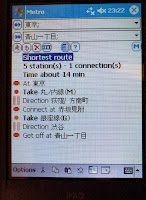The idea is that you send your luggage ahead to your next destination so you don't have to carry it on the train. From Tokyo to Kyoto, it seems takes about two days. We carry our small bags with a couple days of clothes and our "treasures" (souvenirs), and we send our large bags ahead. Most business hotels have the forms and a scale so can send your bags right from the front desk. If you are staying a small ryokan or minshuku, you may have to take your bags to a convenience store like a Lawson.
Here's a copy of a form we used to get our bags send from Kyoto to Tokyo.

You can start the process by saying 「荷物を宅急便でつぎのホテルに送りたいんですが。」(I'd like to send my bags via express delivery to the next hotel, but... ). They will give you a form to fill out. It would take me an hour to fill out one of these because I'd have to look up half the kanji - and then my Japanese handwriting is practically illegible. Here's where it come in handy to have the addresses of all your hotels written in Japanese. You can ask: 「住所を書いてくれませんか。私の漢字は下手です。」(Won't you write the address for me? My kanji is terrible).
Yeah I know the grammar's not quite right, but people seem to understand.
They'll usually fill the whole thing out for you. The top box is the "to" address. For the "from" address, I've seen them use their address (as in the case above), or they've asked me to enter my home address, or they've just put 同上 (same as above). Just make sure your name's on it somewhere so the next hotel will know what to do with it. You also need to give them the date that you want the bag to arrive. They will weigh it, and measure it, and then you will pay. Between Tokyo to Kyoto it's about $15 per bag, and well worth it. In most cases they will give you your receipt and tracking information right there, and you can be on your way. However, when we used ABC/JAL to send our bags to Narita they weren't able to give us a receipt until later that day when the truck came by for a pick-up. For this reason you may want to send your bags on the day before you check out, especially if you don't want to have to return to the hotel later the same day.



